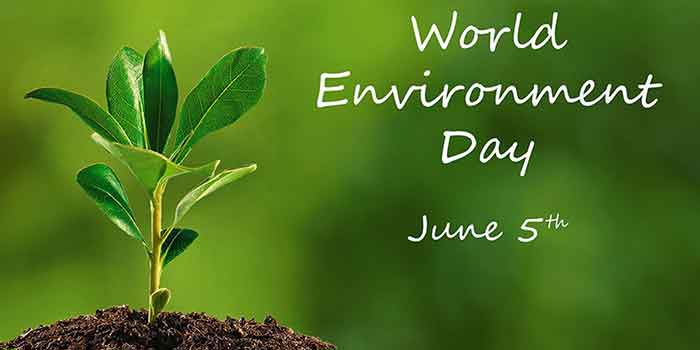
World Environment Day is observed every 5th June, to encourage awareness and action for protecting the environment. It is a “global platform for inspiring positive change” [Ref.1], to address climate crisis caused by global warming (GW).
Homo Sapiens population on Planet Earth was 0.3-billion in 1000, and under 2-billion in 1900. It is currently 8-billion-and-counting. It is only in the last two centuries, that humans have created and efficiently operated social and economic systems, for organized exploitation of Earth’s natural capital of material and energy resources. While these systems have facilitated human population growth, they have also impacted the environment and ecology at planetary level.
Due to accelerating exploitation of Earth’s natural capital, the habitats of many living species on land and in water are getting decimated, triggering species extinction at a staggering rate. The system of resource exploitation is the global economy, the operation of which has caused global warming (GW).
The Global Economy
The global economy comprises industrialised and industrialising national and regional economies. They focus on “economic growth”, which is the increase of economic-financial wealth by large-scale production-trade-commerce, using political-diplomatic-military pressures and sanctions, often with threatening, instigating or actually engaging in armed conflicts.
In every economy, industrial/business/commercial manufacturing and trading corporations are “legal persons”, and biological persons are targetted consumers of goods and services produced by the economy. These corporations balance the interests of shareholders, creditors and clients, and manage resource acquisition and sales-and-advertising to maximize financial profit. The production, trade and commerce of the myriad goods and services of contemporary economies, affects the lives and life-styles of almost all humans on the Planet.
The international banking-financial system comprises banks, insurance companies, and stock exchanges, at national levels, which operate 24×7 to enable and enhance industrial/business/commercial operations. It is a critical component of the global economy, producing and lending money for the economic activities of trade, commerce, and transportation of the goods and services of large-scale industrial production/manufacture.
Money is the yardstick to assess wealth and economic growth. It drives the capital-based economic “machine” of resource extraction, manufacture and production, and purchase and consumption, with transportation at every stage, on all continents. Trading and commercial transactions among nations are based upon inter se value of their monetary currency, the volume and value of exports and imports, and the relative strength of their financial systems, which determines financial debt.
The global economy operates on the basis of compounded year-on-year economic growth, alongwith increasing production and consumption of goods and services. Year-on-year economic growth is based upon repeated industrial-scale cycles of resource extraction, production and consumption. This causes depletion of Earth’s natural capital, destruction of ecosystems, and cumulative growth of pollution. The consequent negative effects on Earth’s environment, and its ecosystems and biospheres, threaten human societies and humans, besides other species.
The impact of the global economy is due to a combination of innovative science-and-technology (S-T) with globalized economics, and the growth of money supply. Even with automation and mechanization of manufacture and production, exploitation of human labour for corporate profit is integral to functioning of the global economy – however, this matter deserves separate discussion.
Industrial products and processes
Every industrially manufactured product – plastics, paper, pins, pens, phones, laptops, cars, airplanes, ships, you-name-it – is finally waste/garbage/junk (WGJ). The fuel and materials consumed at every stage of manufacture and use of every product, show up as WGJ. They remain unwanted or toxic for hundreds, even thousands of years. The least recognized source of WGJ is military-based industrial production, with WGJ greatly magnified during armed conflicts.
Industrialized production consumes natural material resources – especially oil for transportation – from Earth, in continuing cycles of resource depletion, increasing environmental pollution, and ecological destruction.
Industrial processes for re-cycling WGJ also draw on natural resources and energy, and also produce WGJ. Re-using waste – e.g., plastics in concrete for road construction – are gimmicky ideas which barely touch the fringe of the problem.
Industrial-scale atmospheric carbon (carbon dioxide) capture and its geological sequestration cannot address GW. Much like re-cycling, it consumes natural resources and generates WGJ like other industrial processes. In any case, carbon sequestration offers little relief, because carbon dioxide is only a small fraction of industrial waste gases which the global economy pumps into the atmosphere.
Technology innovators propose over-the-top ideas, like projecting chemicals into the stratosphere to reflect away solar heat, and reduce GW. They demonstrate ignorance of energy audit, and the simplistic view that technology can solve GW without itself causing fresh problems. They also fail to appreciate that a problem cannot be solved using the methods that aggravate the problem.
Notwithstanding the foregoing, industrialization is indisputably understood as the way to progress and development, as measured by year-on-year, unending economic growth. The industrialized global economy uses Planet Earth as the Source for extracting material resources, and also as the Sink for disposing industrial wastes. Ivory tower economists make no assessment of the cost of Source depletion and Sink overloading.
Sustainable development
During the Millennium Summit of the United Nations (2000), all UN member States and 22 international organizations, together resolved to eradicate extreme poverty and hunger, achieve universal primary education, promote gender equality, reduce child mortality and maternal health, combat diseases, ensure environmental sustainability, and develop global partnership for development. Accordingly, eight international Millennium Development Goals (MDGs) were formulated for year 2015.
There was dismal progress on MDGs. Besides, with publication of Reports on the scientific investigations and findings of the Inter-governmental Panel on Climate Change (IPCC), goverments began to recognize that Earth’s natural resource base is finite, and cannot support unending, compounded extraction of natural capital, or support its pollution by industries. There was growing albeit incomplete understanding, that Planet Earth cannot sustain the “development” caused by unchecked growth of the global economy.
Thus, in 2015, all UN Member States formulated Sustainable Development Goals (SDGs) to be “a universal call to action to end poverty, protect the planet and improve the lives and prospects of everyone, everywhere”. [Ref.2] The 17 SDGs formulated were part of “Transforming our World: the 2030 Agenda for Sustainable Development“. [Ref.3]
The call for ending poverty and improving the lives and prospects of everyone, everywhere, is undoubtedly laudable. Yet, it displays little understanding that the development model of economic growth is destroying the environment, and that humans (other living species are not even considered) adversely affected first and the most, are those living in poverty. Rather than ending poverty, the global economy worsens poverty.
The SDGs aim “to protect the planet” displays ignorance that Homo Sapiens is part of Planet Earth’s ecosystem, and what humans have done to it, they have done to themselves. It also displays the hubris of self-certification that Homo Sapiens species is the acme of evolution.
Goal-8 of the SDGs is: “Promoting sustained, inclusive and sustainable economic growth, full and productive employment and decent work for all“. The 12 targets in SDG-8 for every national economy, include: “sustained and sustainable economic growth”; “economic productivity”; “resource efficiency”; “promote tourism”; “increase trade”.
Thus, the Goal-8 targets are focussed on economic growth, efficient resource extraction and production, tourism, and trade – which is the existing global economy in new clothing.
Another UN organization, the UN Office for Disaster Risk Reduction (UNDRR), warns that “Risk creation is outstripping risk reduction … as ecosystems and biospheres are at risk of collapse”. It doesn’t require rocket science to understand that risk of ecosystems and biospheres collapsing, is created by the global economy unsustainably imposing the double whammy of using Earth as both Source and Sink. Achieving SDGs may only delay collapse of ecosystems and biospheres, [Ref.4] while the global economy continues preying upon Earth’s eco-systems and biospheres.
At this stage of the present discussion, it is necessary to highlight confusion in the environmental-ecological-social-economics understanding of governments of UN member States, concerning the global economy, and the damage that “development” is imposing on the Planet.
The Davos Development Dogma of economic growth
Governments prioritize the following critical industrial sectors, which drive the growth of every national economy by drawing resources and energy from Earth’s ecosystems and biospheres:
Oil-and-Energy; Banking-finance-trade-commerce; Military; Natural resource extraction; Manufacturing and production; Transportation; Construction; Services including tourism-and-hospitality; Agriculture.
The critical sectors receive attention and financial investments, while sectors such as Education, Health, Social Welfare, Family Welfare, Organized and Unorganized Labour, Small-and-Medium Industry, which immediately benefit the majority of national populations, are neglected.
The World Economic Forum is the oracle for economic development to every national economy. Heads of States and of governments, captains of every type of industry/business of every nation, and public figures, join the annual jamboree at Davos, so that “businesses and governments can make the world a better place for all” [Ref.5] – this echoes the MDG and SDG aims, while both the UN and WEF speak of “transforming our world” [Ref.2].
The Davos participants annually reinforce the nexus between persons holding political power and persons possessing financial power. This nexus aggressively drives economic growth, which consumes natural resources, degrades the environment, and destroys ecological systems and biospheres alongwith the life forms which they sustain.
Ecological predator
As we approach World Environment Day 2023, persons in academia and in governments, and Davos high priest Klaus Schwab and his politician-business devotees in particular, would do well to reconsider the money-driven, unending, destructive, development model of growth of the global economy, while noting that:
# Every industry uses resources and energy extracted from Earth, to produce goods and services.
# Every manufacturing process of goods and services, and transportation between stages of manufacture and consumption – including vehicle manufacture for transportation – generates WGJ.
# Every industrial product is WGJ-of-the-future.
# Energy use generates WGJ.
# All WGJ generated by the global economy is on or in land, water and air of our Planet.
Our world is at risk [Ref.6]. The global economy – the aggregate of national economies – is an ecological predator. It is driving runaway global warming [Ref.7] and climate change, pushing ecosystems and biospheres to collapse. [Ref.6] It threatens Life on Earth.
Instead of trying to “Protect the Planet” – which will manage very well without Homo Sapiens – persons in the political-economic power structure of all nations, need to urgently change focus to ecology-sensitive and People-oriented governance.
~~~~~~~~~~~~~~~~~~~~~~~~~~~~~~~~~~~~~~~~~~~~~~~~~~~~~~~~~~~~~~~
This essay is written for a young woman this writer admires for her ability for independent thought and bold questioning, and whose birthday falls on June 5th.
~~~~~~~~~~~~~~~~~~~~~~~~~~~~~~~~~~~~~~~~~~~~~~~~~~~~~~~~~~~~~~~
References hyperlinked in the text
- “What is World Environment Day?”; <https://www.worldenvironmentday.global/about/history>; United Nations Environment Program.
- “The Sustainable Development Agenda – 17 Goals for People, for Planet”; <https://www.un.org/sustainabledevelopment/development-agenda/>; <https://sustainabledevelopment.un.org/content/documents/21252030%20Agenda%20for%20Sustainable%20Development%20web.pdf>;
- United Nations General Assembly – Resolution adopted by the General Assembly on 25 September 2015; <https://documents-dds-ny.un.org/doc/UNDOC/GEN/N15/291/89/PDF/N1529189.pdf?OpenElement>; October 21, 2015.
- “Our World at Risk”; <https://www.undrr.org/gar2022-our-world-risk-gar>; Global Assessment Report 2022; United Nations Office for Disaster Risk Reduction.
- Robin Pomeroy; “Corporate governance”; <https://www.weforum.org/agenda/2020/01/what-is-davos-myths-and-facts-world-economic-forum/>; World Economic Forum; January 15, 2020.
- “Our World at Risk: Transforming Governance for a Resilient Future“; Global Assessment Report; <https://www.undrr.org/gar2022-our-world-risk-gar>; United Nations Office for Disaster Risk Reduction; 2022.
- Robert Hunziger; “The Ocean Heat Bomb Ignites”; <https://countercurrents.org/2023/05/the-ocean-heat-bomb-ignites/>; Countercurrents.org; May 13, 2023.
~~~~~~~~~~~~~~~~~~~~~~~~~~~~~~~~~~~~~~~~~~~~~~~~~~~~~~~~~~
**Maj Gen S.G.Vombatkere can be contacted at <[email protected]>.
~~~~~~~~~~~~~~~~~~~~~~~~~~~~~~~~~~~~~~~~~~~~~~~~~~~~~~~~~~
















































